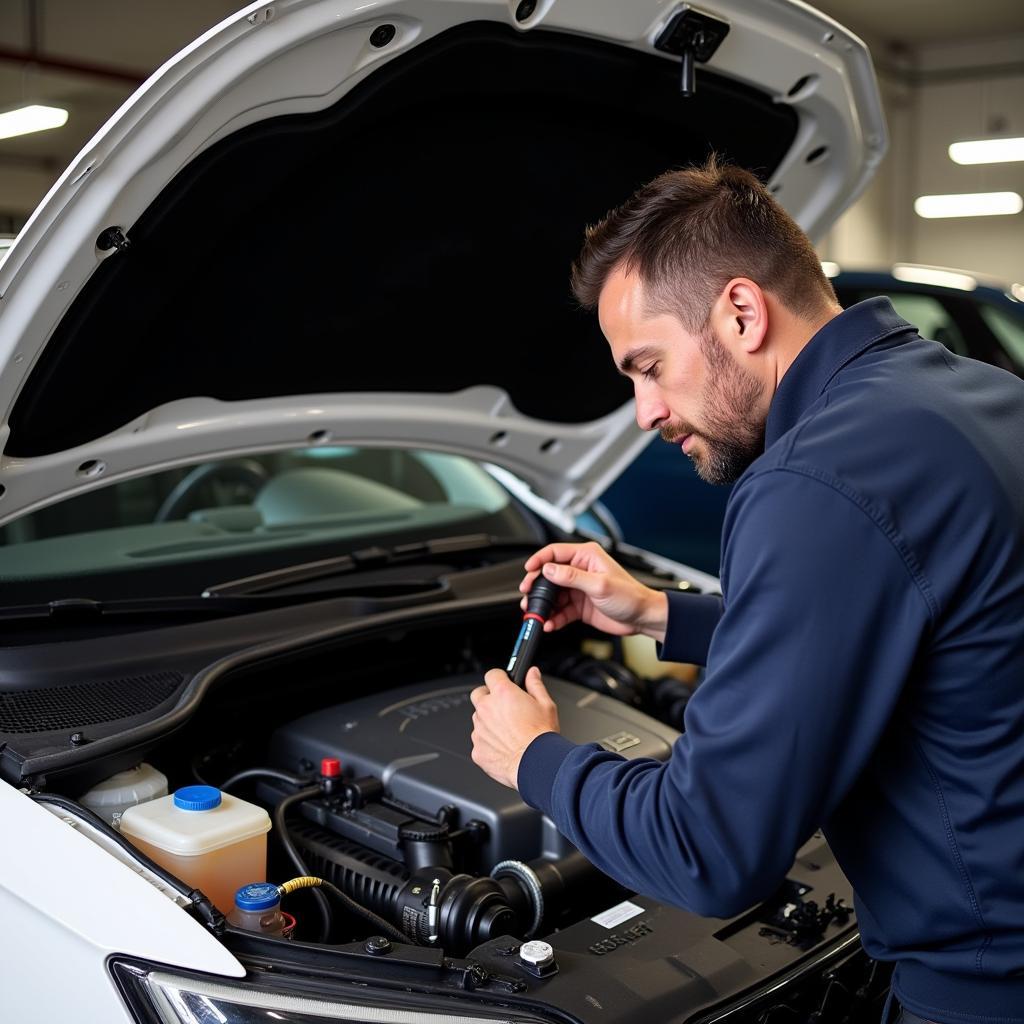The dreaded engine diagnostics warning light on your Seat Ibiza can be a source of anxiety. Understanding its causes and knowing how to address the issue can save you time, money, and unnecessary stress. This guide provides a comprehensive overview of the engine diagnostics warning light in a Seat Ibiza, covering everything from simple checks to more complex diagnostic procedures.
After noticing the engine diagnostics warning light, your first step should be to consult your Seat Ibiza’s owner’s manual. It contains valuable information specific to your model year and can provide initial troubleshooting steps. It might also indicate which warning light is illuminated, as there could be several, each with different meanings. Consulting the manual will often save you time and unnecessary worry.
Understanding the Engine Diagnostics Warning Light
The engine diagnostics warning light, often represented by a stylized engine symbol or the letters “MIL” (Malfunction Indicator Lamp), illuminates when the car’s onboard computer detects a potential problem within the engine or emissions system. This light can indicate a range of issues, from minor sensor malfunctions to more serious engine problems. Don’t panic if you see this light, but don’t ignore it either. Prompt diagnosis is key to preventing further damage and ensuring your Seat Ibiza runs smoothly.
seat ibiza engine diagnostics warning light can be easily addressed with proper diagnosis. For less critical warnings, you may find information about the seat ibiza yellow warning light.
Common Causes of the Engine Diagnostics Warning Light in a Seat Ibiza
Several factors can trigger the engine diagnostics warning light in a Seat Ibiza. Some of the most common include:
- Faulty Oxygen Sensor: The oxygen sensor monitors the exhaust gases to optimize fuel efficiency. A malfunctioning sensor can lead to increased emissions and reduced fuel economy.
- Loose or Damaged Gas Cap: A loose or damaged gas cap can cause fuel vapors to escape, triggering the warning light. This is often the easiest fix!
- Malfunctioning Catalytic Converter: The catalytic converter reduces harmful emissions. A failing converter can significantly impact your vehicle’s performance and increase emissions.
- Spark Plug or Ignition Coil Problems: Issues with spark plugs or ignition coils can cause misfires, leading to reduced power and increased fuel consumption.
- Mass Airflow Sensor (MAF) Issues: The MAF sensor measures the amount of air entering the engine. A faulty MAF sensor can lead to incorrect fuel-air mixtures, affecting performance.
Diagnosing the Problem
While a simple loose gas cap might be the culprit, more complex issues require professional diagnostics. Using a diagnostic scanner, a mechanic can read the specific trouble codes stored in the car’s computer. These codes pinpoint the source of the problem, allowing for targeted repairs.
 Mechanic Using a Diagnostic Scanner on a Seat Ibiza
Mechanic Using a Diagnostic Scanner on a Seat Ibiza
“A proper diagnosis using a professional-grade scanner is crucial,” says John Miller, a seasoned automotive electrical engineer. “Trying to guess the problem can lead to unnecessary repairs and wasted money.”
Remote Diagnostics and Programming: A Modern Solution
Modern technology allows for remote diagnostics and programming, offering a convenient and efficient solution for some engine diagnostics warning light issues. This involves connecting your Seat Ibiza to a specialized diagnostic tool that communicates with a remote technician. The technician can then analyze the data, diagnose the problem, and even reprogram certain modules remotely. This can save you a trip to the repair shop, especially for software-related issues.
What to Do When the Engine Diagnostics Warning Light Appears
- Check the Gas Cap: Ensure the gas cap is securely tightened.
- Consult the Owner’s Manual: Look for specific information related to your Seat Ibiza model.
- Monitor the Light: If the light remains on after tightening the gas cap, schedule a diagnostic appointment.
- Avoid Aggressive Driving: Drive conservatively until the issue is resolved.
- Seek Professional Help: If the light is flashing, it indicates a serious problem. Seek professional assistance immediately.
seat ibiza dashboard warnings offer valuable insights into your car’s health. Understanding them is crucial for maintaining your vehicle’s performance and safety. Don’t overlook seemingly minor warnings like the indicator seat belt warning, as they often point to underlying issues. While our focus is on Seat Ibiza, understanding warning lights in other vehicles, such as the brake system warning light chevy sonic, can broaden your knowledge of car diagnostics.
 Mechanic Inspecting the Engine Bay of a Seat Ibiza
Mechanic Inspecting the Engine Bay of a Seat Ibiza
Conclusion
The engine diagnostics warning light in your Seat Ibiza is a crucial indicator of potential issues. Understanding its causes and taking appropriate action can save you time and money. While some fixes might be as simple as tightening the gas cap, others require professional diagnostics and repair. Don’t ignore this warning light. Address it promptly to ensure your Seat Ibiza continues to perform optimally.
“Remember,” adds Maria Sanchez, another expert in automotive electronics, “regular maintenance is the best way to prevent many of the issues that trigger the engine diagnostics warning light.”
FAQ
- What does a flashing engine diagnostics warning light mean? A flashing light usually indicates a severe problem requiring immediate attention.
- Can I drive my Seat Ibiza with the engine diagnostics warning light on? You can drive short distances, but avoid aggressive driving and seek professional help.
- How much does it cost to diagnose the engine diagnostics warning light? Diagnostic costs vary but typically range from $50 to $150.
- Can I reset the engine diagnostics warning light myself? While you can sometimes reset the light temporarily, it’s best to address the underlying issue.
- Is it safe to ignore the engine diagnostics warning light? Ignoring the light can lead to further damage and potentially costly repairs.
- How often should I get my Seat Ibiza diagnosed? Regular check-ups, at least annually or as recommended in your owner’s manual, are essential.
- Can remote diagnostics fix all engine problems? While remote diagnostics can address software and some sensor issues, physical repairs often require a hands-on approach.
